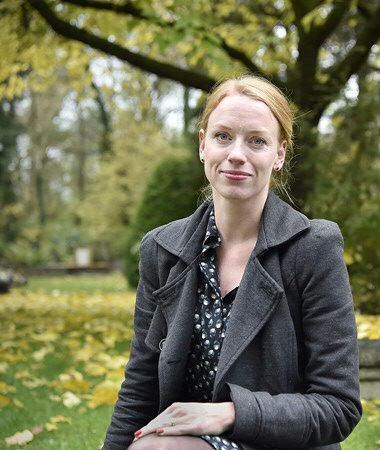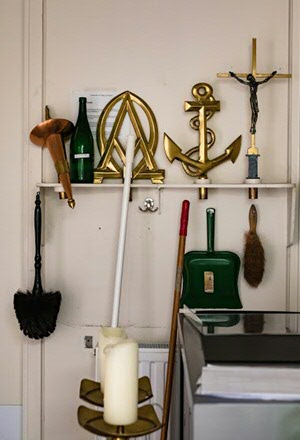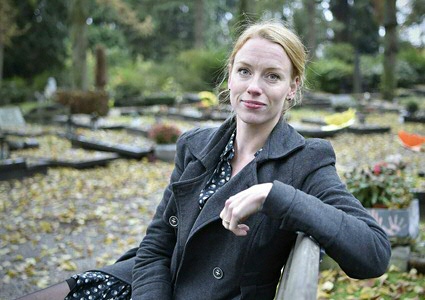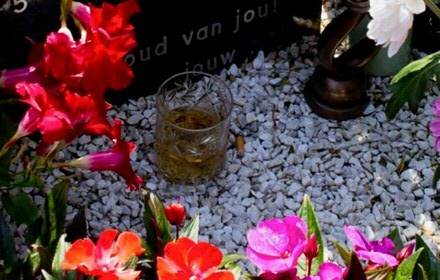Stories of the dead
As a child, she wanted to become a surgeon. Now, although she doesn’t make any incisions, Brenda Mathijssen does take a deep look into people’s souls. As a religious scientist, she researches funeral rites and the ways in which those left behind give meaning to the death of a loved one. It brought her into intimate situations – to even inserting a coffin into a cremation chamber.
Text: Eelco Salverda, Communication UG / photos: Elmer Spaargaren

‘What is it that makes us human – that is what has always interested me. If you want to know what truly moves people, you need to look at death.’ This is how Brenda Mathijssen explains the route she took after her degree in religious studies. She knows the averages, the statistics, the numbers about funerals, but that is not what she is interested in. ‘What I am looking for is the personal story, what it is that people value. It is interesting to study the dynamics between the bereaved and the undertaker, because it reveals what the deceased has meant to other people.’ Even so, how is it possible to research something so private, at a time when someone is caught between wishes and impossibilities, sadness and comfort, emotions and financial decisions?
Undertaker’s right hand
Mathijssen works together with undertakers, talks to the bereaved and helps in the organization of funerals. Of course, it is not easy for people to have a stranger in their home when they have lost a wife, a father or a child just a few hours before. Mathijssen is aware of the delicacy of the situation and the influence that her presence can have. ‘People may find it more difficult to talk in the presence of a stranger, and if I say that I am a researcher I am immediately seen as some kind of authority, which influences the process. The undertaker therefore always asks first if it is okay for someone who wants to find out more about funerals to accompany him or her.’ Mathijssen meets the bereaved on several occasions, and often provides the listening ear that they need.

The cremation chamber
‘A relationship grows as you visit people several times at home, are there at the funeral and talk about how it was afterwards.’ This can lead to some very special, intimate experiences. An example is the time that, at the family’s request, she stood in for an undertaker who was ill – she led the ceremony and helped to place the coffin in the cremation chamber. ‘Luckily I had a lot of support: a plan had already been drawn up, a speaker had been arranged and the family did a lot themselves. But I don’t hesitate if I get such a personal request, and I was happy to be able to help the family.’ Even so, it is possible to get too involved.
Keeping distance
Mathijssen is aware that she should not stay in touch for too long. ‘For the bereaved, things do not end with the funeral, because the deceased stay with us. However, it is not for me to provide long-term support. In some cases, I need to consciously reduce the amount of contact to help the bereaved move on. I support them by referring them to other people or organizations who can help.’

Spellbound
How does she deal with other people’s suffering? Is Mathijssen never overcome by grief? ‘Yes, I cry sometimes. You hear such personal, touching stories. But in general, it is less of a strain than I thought it would be.’ As she talks, she gets lost in her thoughts. ‘You don’t forget anyone; I can still remember them all clearly.’ You can see her thinking, choosing her words and reliving memories of funerals. She casts her eyes up towards the ceiling, making gentle gestures with her hands. It is almost possible to see the images in her head floating above the table. For a while she seems to get emotional, then almost upset as the conversation takes a different turn. It feels almost irreverent to break the spell.
Dr Death
She has also been known to call herself Dr Death, making light of a macabre subject. ‘My students came up with the name, and I sometimes use it. After all, despite being so open about death, it can still be difficult to talk about it and the emotions that it invokes. Making a joke can help break the ice a little and initiate a conversation.’ How do strangers react when she tells them about her research? ‘Some people quickly move on to another subject, while others are very keen to share their own experiences with death and loss. No, I don’t mind, I enjoy listening to people.’
Symbols and structures
The ongoing secularization in society has brought about a lot of change in the sector. Very often now, the family leads the funeral or makes a speech, and different music, different settings and different locations are used. ‘But a ritual is never new,’ says Mathijssen, ‘and we still see the traditional church funeral in everything we do.’ She lists the elements: the music, the life story, the significance that we attach to someone’s life, what the deceased has meant to us, and our place in the universe. ‘The Christian meaning of symbols is fading, and they are being interpreted in different ways. But the structure of a funeral remains the same. People know what to expect, and that gives a sense of unity.’

Individualism
If funerals reflect the changes taking place in society, what changes does Mathijssen see? ‘People have more of an input into what a funeral looks like, and there is more emphasis on the individual. I have even seen someone dressed in their swimming trunks in a coffin! On the other hand, people are looking to make a connection: they want to be part of something bigger than them. So, unique, but still part of a shared set of values.’ It is only human, to want to be different yet to belong, and when it comes to a funeral, our preferences are less unique than we might think.
Skeletons in the cupboard
Death makes it clear what really matters in life – a cliché, perhaps, but true. It is also a time for reflection and for putting the past to rest. Or, as Mathijssen puts it so well: for letting the skeletons out of the cupboard. ‘Do not speak ill of the dead, we say, but that doesn’t work at a funeral. The bereaved often want to talk about the less pleasant aspects or characteristics too, even if just in passing. This adds depth to a person’s character and gives an honest picture. It also does justice to the experiences of those left behind. After all, a funeral is ultimately for them too.’ It is a kind of emotional cleansing process, similar to the physical cleansing rituals seen in other cultures.
Serving a higher purpose
Everybody thinks at some point about what will happen after they die. Some people even write down their life story and select their music years in advance. Why do we do this? ‘Old people often don’t want to be a burden. They may also want to make it clear who they really were, or how they lived their life. When they die, they want to wear their favourite clothes, a certain pair of glasses, or a certain colour of nail polish. People also want to have some control over the memories that remain. For example, they may want to serve a higher purpose just one more time, by contributing to cancer research, or settling a family quarrel.’
Own funeral
With all her experiences, has Mathijssen got some ideas for her own funeral? ‘I don’t think a lot about it, and in fact the more I see, the less it matters to me. There is no one particular ritual that appeals to me, although I do think that cemeteries are beautiful places and that they say a lot about our culture, so I would like to be buried.’
The story of life
In any case, she hopes to leave something behind. ‘I would like to contribute to a more open funerary culture, for example by helping people to talk about what death means in the Netherlands. We cry in our homes or with our therapist, we are buried outside our cities, we leave our funeral arrangements to a professional and we find adverts about funeral insurance mostly inappropriate. Even our commemorations of the dead, such as the traditional All Souls’ Day, pass many people by, while they give us a chance to think about our dead and what they mean to us. Death is not simply the end of life, but has stories to tell us about life.’
Further information
-
Brenda Mathijssen
- Brenda Mathijssen and Claudia Venhorst recently published
Funerary Practices in the Netherlands , in which they provide an overview of funerary history and contemporary practice.
